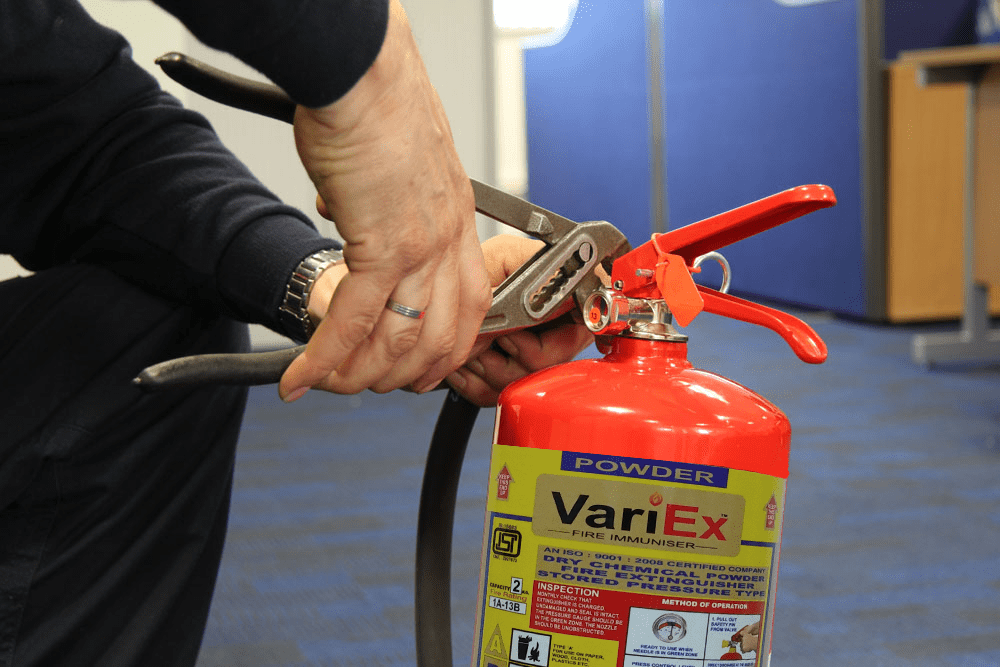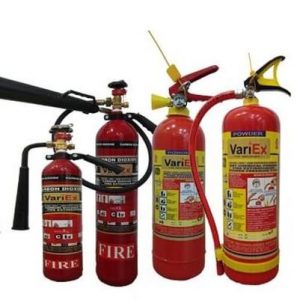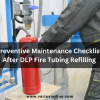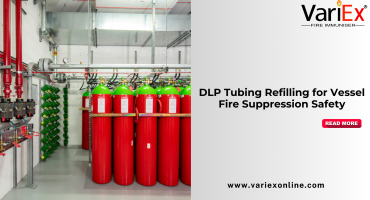![]()
Fire Immuniser
+91-7829629111
Email: info@variex.in
Varistor Technologies Pvt. Ltd.
Block-1, First Floor, Ardente Office One, Hoodi Circle, ITPL Main Road, Bengaluru, Karnataka 560048, IN
Fire extinguishers refilling: Discover When, Why, and How to Do It
Today, we're talking about something important – your fire extinguisher. It's not just a wall accessory; it's like your safety superhero. Our guide on 'Fire Extinguishers Refilling: Discover When, Why, and How to Do It' is your go-to for understanding the basics. We're not just diving into routine stuff – we're giving you the lowdown on when to refill, why it's essential, and how to do it. It's like a crash course in making sure your fire safety game is on point. Ever thought about when it needs a little boost, why it's crucial, and how to do it? Well, you're in for a treat! We're here to chat about when, why, and how to refill your fire extinguisher. Let's make sure it's always geared up to protect you from those unexpected flames!
The purpose of the refill of the fire extinguisher
Power Boost - Charging Up for Action: Your fire extinguisher is like a superhero with limited power. The refill is its way of charging up, ensuring it's always ready for action. It's akin to plugging in your phone before a busy day – making sure it's at full strength to handle any fiery situation that comes its way.
Pressure Check - Maintaining Strength: Think of your fire extinguisher as a can of soda. A full can sprays its contents with force, but a half-empty one lacks that punch. Refilling maintains the right pressure, guaranteeing that when you activate your extinguisher, it delivers a powerful burst capable of swiftly handling the heat.
Always on Standby - Prepared for Anything: Fires don't follow a schedule. They can spark up anytime, anywhere. Refilling your fire extinguisher is like giving it a pep talk, reminding it to stay ready because emergencies don't wait. It's a proactive measure, ensuring your safety equipment is on standby, ready to be the hero whenever it's needed.
Maintenance Matters - A Reliable Sidekick: Visualize your fire extinguisher as a trusty sidekick in a superhero duo. Regular refills keep it in top-notch condition, always prepared to leap into action. It's not just about ticking off a checklist; it's a commitment to ensuring your safety gear is as reliable as your closest ally.
Why do fire extinguishers need to be recharged?
Fire extinguishers need to be recharged to ensure they remain fully operational and effective in the event of a fire emergency. The process of recharging is essential for maintaining the extinguisher's pressure at the required level. Over time, factors such as accidental discharges, partial discharges, or natural dissipation can lead to a decrease in pressure. Recharging involves refilling the extinguisher with the appropriate extinguishing agent and pressurizing it to the recommended level.
By undergoing regular recharging, fire extinguishers address potential malfunctions and ensure that the equipment is ready for use. This proactive measure is crucial for preventing failures when the extinguisher is needed the most. It also helps in complying with safety standards set by organizations like the National Fire Protection Association (NFPA), which mandate specific pressure levels and charging requirements for fire extinguishers.
Moreover, recharging contributes to the extended service life of fire extinguishers. It helps rectify deficiencies and ensures that the equipment remains viable for a more extended period, providing long-term value. The readiness of fire extinguishers for emergencies is paramount, and recharging is a key aspect of maintaining this readiness. It ensures that the extinguisher is fully charged, pressurized, and operational when required, facilitating a swift and effective response to a fire incident.
The Importance of Proper Inspection and Maintenance for Fire Extinguishers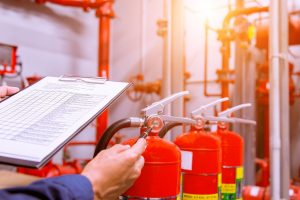
Understanding the Significance
Why Proper Inspection Matters: Much like a health check for our bodies, regular fire extinguisher inspections ensure the vitality of our safety equipment. These assessments go beyond surface appearances, detecting potential issues before they can manifest into emergencies.
The Role of Maintenance: Maintenance operates as the unsung hero working behind the scenes. It involves meticulous care, safeguarding every internal component to ensure that your fire extinguishers aren't just visually ready but genuinely prepared for the unpredictable challenges they may face.
The Impact on Emergency Preparedness
Swift and Effective Response: In emergencies, every moment counts. Properly inspected and maintained fire extinguishers are poised for a rapid and efficient response, providing a reassuring sense of control amidst chaos.
Preventing Equipment Failure: Emergency scenarios are not the time for equipment failure. Routine inspections and maintenance serve as preemptive measures, mitigating the risk of malfunctions and transforming your fire extinguisher into a reliable safety net.
The Routine Checks You Need
Visual Inspections: A swift glance to ensure external integrity serves as the initial checkpoint. Visual inspections offer insights into any apparent damages that may compromise the functionality of the fire extinguisher.
Pressure Levels: Maintaining the optimal pressure within the extinguisher is paramount. Routine pressure checks guarantee that it remains adequately charged, ready for a potent discharge when necessity calls.
Functional Testing: Just as exercise maintains our physical health, functional testing involves a controlled discharge to confirm the operational health of the extinguisher, ensuring that the mechanism functions seamlessly.
When to get a recharge for your fire extinguishers
According to the 2022 edition of NFPA 10, the guidelines recommend getting a recharge for your fire extinguishers under the following circumstances:
- After Each Use:
- If you've used your fire extinguisher, even partially, it is recommended to recharge it. This ensures that the extinguisher is fully prepared for any subsequent emergencies.
- During Regular Inspections:
- Regular inspections, in accordance with NFPA 10, are essential. If any issues or concerns are identified during these inspections, it is advisable to proceed with a recharge to maintain optimal functionality.
- When Pressure is Below Recommended Levels:
- Monitoring the pressure levels is crucial. If the pressure gauge indicates that the extinguisher is below the recommended levels, a recharge is necessary to ensure effective operation.
- If Visual Inspections Reveal Damage:
- Visual inspections, as per NFPA 10, are conducted to identify visible damages. If any dents, corrosion, or other visible damages are observed, a recharge is recommended to address potential issues.
- As Per Manufacturer's Recommendations:
- Manufacturers often provide specific guidelines for the maintenance and recharge of their fire extinguisher models. It is advisable to follow these recommendations to ensure compliance and optimal performance.
- In Accordance with Local Regulations:
- Local safety codes and regulations may specify intervals for recharging fire extinguishers. Adhering to these local guidelines is essential for maintaining compliance and promoting overall safety.
If you've used the extinguisher, even partially, it's time for a recharge to restore its full capacity. Regular visual inspections help identify visible damages or issues, and if concerns arise, a recharge is in order. Keep an eye on the pressure gauge; if it falls below recommended levels, a recharge is necessary for an effective discharge during emergencies. Follow the manufacturer's recommendations for maintenance and recharge to ensure optimal functioning. Check local regulations for specified recharge intervals, as adherence is vital for compliance and overall safety.
Even if unused, periodic recharging is advisable to address factors like natural dissipation or potential leaks that may affect pressure levels. Staying proactive with maintenance and recharging ensures your fire extinguisher is always ready to serve as a reliable defense in case of a fire.
How are fire extinguishers recharged?
Recharging a fire extinguisher is a bit like giving it a power boost. Imagine your extinguisher as a superhero that needs to be ready for action at all times. When it's been used or if the pressure is too low, it's time for a recharge. Here's how it works: First, the professionals take your extinguisher and remove any remaining agent inside. Then, they refill it with a fresh batch of the firefighting stuff – think of it like refilling a water gun. After that, they make sure the pressure is just right, like filling up a tire. Finally, they put it all back together, and your extinguisher is good to go, ready to tackle any future fire emergencies. It's like giving your safety superhero a fresh set of powers!
Do all fire extinguishers need to be recharged?
Not all fire extinguishers need to be recharged. It depends on the type of extinguisher and whether it is designed to be rechargeable or for one-time use. Rechargeable fire extinguishers, such as those using dry chemical, water, foam, or CO2, can be refilled and pressurized after use. On the other hand, non-rechargeable extinguishers, often containing agents like Halon or certain clean agents, are intended for single use and cannot be refilled. The decision on rechargeability is influenced by factors like the type of extinguishing agent, environmental considerations, and the design of the extinguisher. It's important to follow the manufacturer's guidelines and industry standards to determine whether a specific fire extinguisher needs recharging. Regular inspections help assess the condition of rechargeable extinguishers and ensure compliance with maintenance guidelines.
- Single-Use Extinguishers: Some fire extinguishers are designed for one-time use and cannot be recharged. Once these extinguishers are discharged, they need to be replaced.
- Rechargeable Extinguishers: Many modern fire extinguishers are rechargeable. These can be refilled and pressurized after use or during routine maintenance to ensure they remain ready for future use.
- Regular Inspection: All fire extinguishers, regardless of type, should undergo regular visual inspections. If there are visible signs of damage or if the pressure gauge indicates low pressure, it's an indication that further action, such as a recharge, may be necessary.
- Maintenance Intervals: Standards such as those outlined by the National Fire Protection Association (NFPA) often provide guidelines on maintenance intervals for fire extinguishers. Following these recommendations helps ensure that rechargeable extinguishers are serviced at appropriate intervals.
- Local Regulations: Local safety codes and regulations may also stipulate requirements for fire extinguisher maintenance, including recharging. Adhering to these regulations is essential for compliance and safety.
- Type of Extinguisher: The type of extinguishing agent in the fire extinguisher can influence the need for recharge. For example, certain chemicals may degrade over time, requiring replenishment.
Rechargeable Fire Extinguishers:
- Dry Chemical (ABC, BC): These extinguishers, commonly used for general-purpose fire protection, are often rechargeable. They contain a dry chemical powder that can be refilled and pressurized after use.
- Water and Foam: Water and foam extinguishers are typically rechargeable. They use water or a mixture of water and foam concentrate as the extinguishing agent. After use, the extinguisher can be refilled, ensuring it's ready for future incidents.
- Carbon Dioxide (CO2): CO2 fire extinguishers, suitable for electrical and flammable liquid fires, are rechargeable. They use carbon dioxide gas as the extinguishing agent and can be refilled after use.
Non-Rechargeable Fire Extinguishers:
- Halotron and Clean Agents (HCFC, HFC, Halon): Halotron and clean agent fire extinguishers, designed for sensitive electronic equipment, are typically non-rechargeable. Once discharged, they cannot be refilled due to environmental concerns and the desire to avoid potential contamination.
- Water Mist and Water Additive: Certain water mist and water additive extinguishers are designed as non-rechargeable. This is often due to the complexity of their internal components and the challenges associated with refilling.
Why Some Extinguishers are Non-Rechargeable:
- Environmental Concerns: Extinguishers containing agents like Halon or certain clean agents are non-rechargeable due to environmental regulations. These agents have been phased out because of their impact on the ozone layer.
- Complexity of Components: Some extinguishers have intricate internal components, making the recharge process challenging or impractical.
- Manufacturer's Design Choice: The design and intended use of the extinguisher influence whether it is made to be rechargeable or for single-use.
When to replace your rechargeable fire extinguisher?
The decision to replace is influenced by factors such as the extinguisher's age, the type of extinguishing agent it contains, and any damage or wear observed during inspections. If the extinguisher is approaching the end of its recommended service life, it may be time for a replacement. Additionally, if there are signs of corrosion, leakage, or irreparable damage, replacement is advisable. Regular inspections play a crucial role in assessing the extinguisher's condition and determining when a replacement is warranted. Adhering to manufacturer guidelines, industry standards, and local regulations ensures that your fire protection equipment is reliable and ready for emergencies.
In conclusion, understanding when, why, and how to refill your fire extinguisher is not just a matter of routine maintenance; it's a proactive step towards ensuring the safety of your surroundings. Knowing the signs that signal a need for recharge, comprehending the importance of maintaining optimal pressure levels, and being aware of the process itself empower you to be a vigilant guardian against potential fire emergencies. By embracing the responsibility of keeping your fire extinguisher ready for action, you contribute to a safer environment, ready to face unforeseen challenges with confidence. Stay informed, stay prepared, and let your refilled fire extinguisher stand as a testament to your commitment to safety.
Frequently Asked Questions
1. Why is it necessary to refill a fire extinguisher?
Refilling a fire extinguisher is crucial to maintain the optimal pressure levels and ensure its effectiveness during an emergency. It replenishes the extinguishing agent, making the extinguisher fully charged and ready for use.
2. When should I consider refilling my fire extinguisher?
Refill your fire extinguisher if you've used it, even partially, during an emergency. Additionally, regular inspections may reveal low pressure or visible damage, signaling the need for a recharge.
3. How often should I inspect my fire extinguisher for potential refilling?
Regular visual inspections are recommended, and if any issues are detected, immediate action should be taken. It's also advisable to follow the guidelines provided by safety standards and regulations.
4. Can I refill my fire extinguisher myself?
Fire extinguisher refilling is a task best left to professionals. DIY attempts may lead to improper pressurization or the use of incorrect extinguishing agents, compromising the extinguisher's effectiveness.
5. What is the typical process for refilling a fire extinguisher?
The process involves discharging any remaining agent, cleaning and inspecting internal components, refilling with the appropriate extinguishing agent, pressurizing to the recommended level, and conducting quality checks before reassembly.
6. Are all fire extinguishers rechargeable?
Not all fire extinguishers are rechargeable. It depends on the type of extinguisher and the extinguishing agent it contains. Some are designed for one-time use and must be replaced after discharge.
Final Say
We at VariEx.in or Variexonline.com have mastered the art of designing, installing, inspecting, and fixing automatic sprinkler systems with the help of our in-house team, which is capable of delivering the fire sprinkler services you need, whether large or small and at affordable cost.
To schedule a fire sprinkler installation, or you think our services could benefit your commercial property, contact us online or give us a call at, 7829629111
"WHAT YOU CAN READ NEXT"
 Read more +24 November 2023 in Fire Extinguisher
Read more +24 November 2023 in Fire ExtinguisherWhat types of fire extinguishers are available for different fire classes?
 Read more +11 July 2025 in Fire Suppression
Read more +11 July 2025 in Fire Suppression

